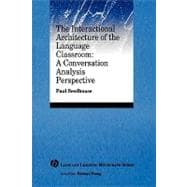
| Series Editor's Foreword | x | ||||
| Acknowledgments | xiv | ||||
| Chapter 1 Conversation Analysis Methodology | 1 | (54) | |||
|
1 | (2) | |||
|
3 | (3) | |||
|
6 | (6) | |||
|
7 | (1) | |||
|
7 | (2) | |||
|
9 | (1) | |||
|
10 | (1) | |||
|
11 | (1) | |||
|
12 | (1) | |||
|
13 | (3) | |||
|
16 | (22) | |||
|
17 | (5) | |||
|
22 | (5) | |||
|
27 | (7) | |||
|
34 | (4) | |||
|
38 | (4) | |||
|
42 | (4) | |||
|
46 | (6) | |||
|
52 | (1) | |||
|
53 | (2) | |||
| Chapter 2 Different Perspectives on Language Classroom Interaction | 55 | (46) | |||
|
55 | (11) | |||
|
66 | (15) | |||
|
81 | (3) | |||
|
84 | (1) | |||
|
84 | (4) | |||
|
88 | (5) | |||
|
93 | (2) | |||
|
95 | (4) | |||
|
99 | (1) | |||
|
99 | (2) | |||
| Chapter 3 The Organization of Turn Taking and Sequence in Language Classrooms | 101 | (40) | |||
|
102 | (9) | |||
|
111 | (8) | |||
|
119 | (14) | |||
|
133 | (3) | |||
|
136 | (2) | |||
|
138 | (1) | |||
|
139 | (2) | |||
| Chapter 4 The Organization of Repair in Language Classrooms | 141 | (40) | |||
|
143 | (6) | |||
|
149 | (4) | |||
|
153 | (5) | |||
|
158 | (1) | |||
|
159 | (4) | |||
|
163 | (1) | |||
|
164 | (4) | |||
|
168 | (4) | |||
|
172 | (1) | |||
|
172 | (3) | |||
|
175 | (1) | |||
|
176 | (3) | |||
|
179 | (1) | |||
|
179 | (2) | |||
| Chapter 5 The Organization of Language Classroom Interaction | 181 | (42) | |||
|
183 | (4) | |||
|
184 | (1) | |||
|
184 | (2) | |||
|
186 | (1) | |||
|
187 | (7) | |||
|
194 | (5) | |||
|
199 | (5) | |||
|
204 | (4) | |||
|
208 | (7) | |||
|
212 | (1) | |||
|
212 | (1) | |||
|
212 | (3) | |||
|
215 | (4) | |||
|
219 | (2) | |||
|
221 | (1) | |||
|
221 | (2) | |||
| Chapter 6 Conversation Analysis, Applied Linguistics, and Second Language Acquisition | 223 | (40) | |||
|
224 | (12) | |||
|
226 | (1) | |||
|
227 | (1) | |||
|
228 | (1) | |||
|
229 | (1) | |||
|
230 | (1) | |||
|
231 | (1) | |||
|
231 | (2) | |||
|
233 | (1) | |||
|
234 | (2) | |||
|
236 | (1) | |||
|
237 | (12) | |||
|
241 | (8) | |||
|
249 | (4) | |||
|
253 | (8) | |||
|
261 | (1) | |||
|
262 | (1) | |||
| Chapter 7 Epilogue | 263 | (4) | |||
| Appendix 1 Transcription Conventions | 267 | (4) | |||
| Appendix 2 Resources for Conversation Analysis Research in Applied Linguistics and Second Language Acquisition | 271 | (2) | |||
| References | 273 | (18) | |||
| Index | 291 |
The New copy of this book will include any supplemental materials advertised. Please check the title of the book to determine if it should include any access cards, study guides, lab manuals, CDs, etc.
The Used, Rental and eBook copies of this book are not guaranteed to include any supplemental materials. Typically, only the book itself is included. This is true even if the title states it includes any access cards, study guides, lab manuals, CDs, etc.